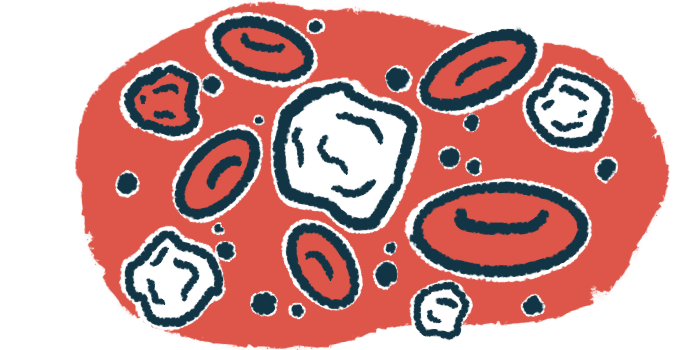Early and Deep B-cell Depletion Predicts Better Response to Uplizna
N-MOmentum data points to importance of cell-count drop after 1st dosing period
Written by |

Among people with neuromyelitis optica spectrum disorder (NMOSD) who started treatment with Uplizna (inebilizumab-cdon) in a clinical trial, an early and strong reduction in B-cell counts was associated with a quicker decline in disease activity.
This report comes from an analysis of data from the Phase 2/3 N-MOmentum trial (NCT02200770), which showed that the therapy was superior to a placebo at lowering attacks and easing disability in NMOSD patients.
“Depth of B-cell depletion after the first dosing period correlated with clinical outcomes … [although] all participants receiving [Uplizna] demonstrated a robust long-term therapeutic response,” the researchers wrote.
“The correlation between depth of B-cell depletion and reduction in NMOSD activity with long-term [Uplizna] treatment underscores a central role for B cells in NMOSD [underlying mechanisms] and suggests that early monitoring of B-cell counts could be important for management of [Uplizna]-treated patients with NMOSD,” they added.
Post-hoc trial analysis into how B-cell counts determine depth of Uplizna response
The study reporting these results, “Association between B-cell depletion and attack risk in neuromyelitis optica spectrum disorder: An exploratory analysis from N-MOmentum, a double-blind, randomised, placebo-controlled, multicentre phase 2/3 trial,” was published in eBioMedicine. It was funded by Horizon Therapeutics, which markets Uplizna.
Uplizna is approved in the U.S., Europe, and elsewhere to treat NMOSD patients who test positive for antibodies against aquaporin-4 (AQP4), the self-reactive antibody that drives the disease in most cases.
The therapy works by destroying B-cells, the immune cells responsible for producing antibodies, including the abnormal self-reactive antibodies that mark autoimmunity. It is administered via infusion into the bloodstream every six months following an initial loading dose given two weeks apart.
N-MOmentum, the trial that served as the basis for Uplizna’s approvals, compared the therapy against a placebo in 230 adults with NMOSD. Most enrolled patients, 93%, were positive for anti-AQP4 antibodies.
After the study’s six-month placebo-controlled portion, participants could enter an open-label extension portion where all were treated with Uplizna for up to three years, with average total follow-up time of more than 2.5 years.
Results from its placebo-controlled part showed the therapy significantly reduced the risk of disease attacks and slowed disability progression relative to a placebo, with the depth of the effect increasing the longer patients used Uplizna.
Further analyses showed NMOSD attacks were preceded by an increase in anti-AQP4 antibodies and/or plasma cells — mature, antibody-producing B-cells — in most placebo-group patients but not in those treated with Uplizna.
Now, scientists at Horizon and other institutions conducted a post hoc analysis of N-MOmentum data — that is, an analysis after the trial has finished — to investigate how participants’ clinical outcomes throughout the trial associated with changes in B-cell counts.
“Given that we observed a progressive reduction in NMOSD activity with prolonged [Uplizna] treatment, we hypothesized that the depth of B-cell depletion may correlate with therapeutic efficacy,” the team wrote.
Results showed that patients with up to four B-cell cells/microliter after six months on Uplizna were significantly less likely to experience any NMOSD-related disease activity throughout follow-up.
Most patients (70%) had levels below this cutoff after the first six months of treatment, the researchers noted. Compared with those who didn’t meet the cutoff, these people had persistently lower B-cell counts and significantly fewer NMOSD relapses and new or enlarging brain lesions.
Our data suggest that deep and persistent B-cell depletion is beneficial in preventing attacks with NMOSD.
B-cell counts below the cutoff also associated with slower disability progression and fewer NMOSD-related hospitalizations, though differences here failed to reach statistical significance.
While outcomes were generally better for patients who reached this B-cell cutoff, “all participants treated with [Uplizna] displayed immediate and significant reductions in NMOSD activity compared with those receiving placebo,” the researchers wrote.
Having identified the clinically relevant B-cell count cutoff, the scientists conducted a battery of analyses to assess possible reasons behind Uplizna’s inability to prod B-cell counts below four cells/microliter in some patients.
Results indicated that people not reaching this cutoff had significantly higher B-cell counts prior to treatment, lower levels of Uplizna in the blood, and were more likely to have a genetic variation called FCGR3A F/F.
This variation is known to affect the efficacy of monoclonal antibody therapies like Uplizna. However, the researchers noted that the number of patients with available genetic information was limited, stressing a need for additional studies to confirm this potential link.
In addition, while antibodies against Uplizna were detected in 14.7% of participants at some point during the trial, these did not appear to limit the therapy’s effectiveness.
Notably, with continuous Uplizna use for more than 2.5 years, B-cell counts and disease activity levels among patients who did or did not reach the B-cell cutoff after an initial six months of treatment were comparable.
“Our data suggest that deep and persistent B-cell depletion is beneficial in preventing attacks in patients with NMOSD, and that regular monitoring of B-cell counts may be valuable in informing the most effective use of [Uplizna] for managing patients with NMOSD,” the researchers wrote.
“Validation studies that confirm the correlation of duration and depth of B-cell depletion with clinical response could establish a new paradigm for monitoring and treating patients with [Uplizna],” they added.






